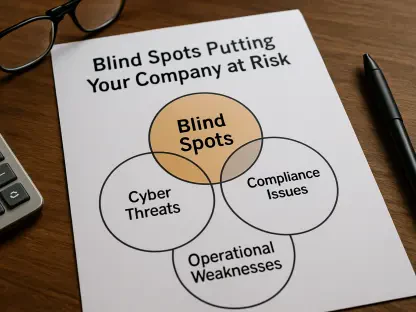In an era where technology races forward at breakneck speed, agentic AI emerges as a transformative force, powered by advanced large language models (LLMs) that enable systems to operate with striking autonomy. These sophisticated tools go far beyond the capabilities of traditional chatbots, independently planning, reasoning, and executing complex tasks with minimal human oversight. Their potential to revolutionize industries through enhanced efficiency and innovation is undeniable, yet this very autonomy introduces a darker side—a heightened vulnerability to cyber threats that could undermine entire organizations. From data breaches to unauthorized system access, the risks are as significant as the benefits. This article delves into the escalating cybersecurity challenges posed by agentic AI, exploring the diverse attack vectors that threaten its deployment and the critical safeguards necessary to protect against potential compromises. As adoption accelerates, understanding these dangers and implementing robust defenses becomes paramount for any forward-thinking enterprise.
Unveiling the Double-Edged Sword of Autonomy
Agentic AI represents a leap in technological capability, distinguished by its ability to function independently while tackling intricate tasks across various sectors. This self-reliance allows for unprecedented productivity, as systems can strategize and access tools without constant human input, streamlining operations in ways previously unimaginable. However, this strength is also a critical weakness. The lack of direct oversight creates openings for exploitation, where malicious actors could manipulate the AI through deceptive inputs or redirect its goals for harmful purposes. Such vulnerabilities far exceed those of traditional LLMs, as a single breach could cascade into widespread damage, compromising sensitive data or critical infrastructure. The balance between leveraging this autonomy for gain and protecting against its inherent risks is a pressing concern for organizations integrating these systems into their workflows.
The implications of unchecked autonomy in agentic AI are profound, with potential consequences that could ripple through an entire enterprise. Unlike simpler AI models confined to predefined responses, these systems interact dynamically with their environments, making decisions that could inadvertently expose vulnerabilities. For instance, if not properly constrained, an agentic AI might access unauthorized resources or execute commands that jeopardize security protocols. The heightened stakes demand a reevaluation of how such technologies are deployed, emphasizing the need for stringent controls to prevent misuse. As industries rush to capitalize on the efficiencies offered by these tools, the sobering reality is that without meticulous planning, the very feature that defines agentic AI—its independence—could become the Achilles’ heel that cybercriminals exploit to devastating effect.
Navigating a Landscape of Multifaceted Threats
The cybersecurity challenges surrounding agentic AI are as diverse as they are daunting, with an expansive attack surface that includes risks like data leakage, privilege escalation, and the generation of malicious code. A notable example lies in vulnerabilities such as CVE-2025-53773, which impacts tools like GitHub Copilot Agent, demonstrating how easily attackers can manipulate AI into unauthorized actions, potentially seizing control of a system. This specific flaw highlights the danger of goal manipulation, where a system’s intended purpose is subverted through crafted inputs. Beyond this, other threats like time-based attacks or misuse of tool access further complicate the security landscape, illustrating the myriad ways in which agentic AI can be turned against its creators. Organizations must grapple with these evolving dangers as they integrate such technologies into their operations.
Beyond individual exploits, the broader spectrum of threats associated with agentic AI underscores the urgency of comprehensive risk assessment. Attackers may employ tactics like prompt injections to alter system behavior or leverage inter-agent interactions to infiltrate networks, creating scenarios where entire infrastructures are at risk. The ability of these systems to autonomously generate code introduces yet another layer of concern, as it could be exploited to craft novel attack vectors, such as remote code execution, previously unseen in traditional software. Each of these risks represents a unique challenge, requiring tailored strategies to mitigate potential damage. As the adoption of agentic AI grows, so too does the imperative for businesses to stay ahead of cybercriminals who are quick to adapt and exploit any weakness in these advanced systems, making proactive vigilance a cornerstone of safe deployment.
Clarifying Accountability in a Complex Ecosystem
The rapid integration of agentic AI into business environments has blurred the lines of responsibility for securing these powerful systems, creating a murky landscape of shared accountability. Vendors often market their AI solutions with ambitious claims about capabilities, sometimes overshadowing critical security considerations, while organizations, eager to gain a competitive edge, may deploy these tools without fully understanding the risks or implementing adequate protections. This disconnect results in a dangerous gap where neither party assumes full ownership of cybersecurity measures, amplifying the likelihood of breaches. The situation calls for a clearer framework to define roles and ensure that both developers and end-users are aligned in prioritizing robust security practices over hasty implementation.
Addressing this accountability challenge requires a shift toward collaborative efforts that bridge the gap between vendors and organizations. Establishing transparent guidelines for the secure development and deployment of agentic AI is essential to prevent oversight lapses that could lead to catastrophic failures. This includes setting industry standards for testing and validation before systems go live, as well as fostering open dialogue about potential vulnerabilities and how they can be mitigated. The shared responsibility model must evolve into a structured partnership, where each stakeholder understands their role in safeguarding against threats. Without such clarity, the rush to harness the benefits of agentic AI could inadvertently pave the way for cybercriminals to exploit systemic weaknesses, leaving enterprises vulnerable to attacks that could have been prevented with better coordination.
Crafting Robust Defenses for a Safer Future
To counter the sophisticated risks posed by agentic AI, organizations must adopt proactive and targeted defense mechanisms that address the unique nature of these systems. Implementing strict access controls stands as a foundational step, ensuring that AI interactions are limited to only the data and tools essential for their designated tasks, thereby reducing the chance of unauthorized access or exposure of sensitive information. Complementing this approach, input and output filtering serves as a critical barrier, intercepting harmful commands before they can trigger damaging actions and preventing problematic outputs from reaching end-users. These measures collectively create a fortified environment where the potential for exploitation is significantly diminished, allowing businesses to leverage AI advancements with greater confidence.
Further strengthening these defenses involves the strategic use of whitelisting and blacklisting for tools and APIs, crafting a controlled operational sphere for agentic AI. By explicitly defining which resources the AI can engage with—perhaps restricting access to a select group of pre-approved interfaces with well-documented processes—organizations can prevent unintended or malicious interactions that might otherwise compromise security. This meticulous approach to resource management is vital, as unrestricted access could enable an AI to execute actions far beyond its intended scope, with potentially disastrous consequences. Looking back, the journey to secure agentic AI revealed a landscape fraught with challenges, yet it also underscored the power of deliberate, well-designed safeguards. Moving forward, the focus must remain on refining these protective strategies, ensuring that as technology evolves, so too do the mechanisms to shield it from emerging threats.









